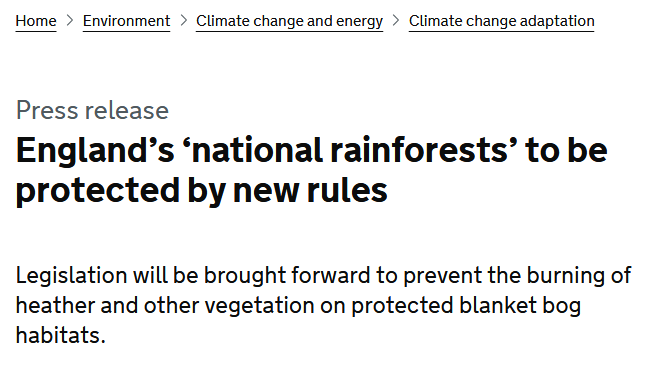
This post is about the announcement, long-awaited announcement, overdue announcement, that DEFRA made on Friday about burning on blanket bogs. I’ll tell you what I think in the hope that it influences what you think. I’ve read the announcement, and thought about it, and that probably helps.
1. The announcement is good news
The announcement is good news – it regulates the environmental harm caused by burning of vegetation on peat soils, mostly upland peat soils. What is the harm? The harm is manifold: blanket bog is a priority habitat under EU legislation adopted by the UK and burning it damages it. Stopping damage to a habitat, as the words above say, ‘protected habitat’, is a good thing. Moreover, burning blanket bog habitats leads to increased carbon emissions, water discolouration, increased flood risk in times of heavy rain and other disruption of ecological services. All of these impacts affect people’s pockets. George Eustice’s quote recognises these impacts.
Interestingly, the announcement does not hint at the fact that most of the damage done to blanket bogs is done by upland land managers pursuing the niche hobby of shooting Red Grouse for fun – it’s almost as though we were all up in the hills carrying out this damage.
The organisation which deserves most credit for this advance is the RSPB which in its dogged advocacy, largely behind the scenes, has painstakingly pressed and prodded successive Conservative Secretaries of State at DEFRA to get this fixed, Back in 2012, yes 2012, the RSPB complained to the EU Commission and the Commission took up this complaint (slowly) and by the time Michael Gove was at DEFRA something had to give. Things would have moved quicker, no doubt, and probably more decisively, had some of you not voted for Brexit, but even with that handicap, things have continued to move.
Friends of the Earth and the Climate Change Committee have latterly played important roles too. This blog has done its little bit. On the ground local campaigners such as those at Hebden Bridge have been important too, and individuals such as Bob Berzins and a range of Moorland Monitors, as well as very forcefully Ban Bloodsports on Yorkshire’s Moors, have played important roles more recently. As these things always are, it has been a team effort, but, in my view, the RSPB has played the crucial and pivotal role when few others were that bothered – well done them! Although, a serious review of whether the RSPB could have got us here much quicker would probably find that they could have done (IMHO). But, without the staid RSPB we would not have got here at all. And we are in a better position today than last Monday thanks to this announcement.
But now the question is, are we in a brilliant position or a slightly less crap position, or somewhere in the middle?
2. What does the announcement actually promise?
The critical words are these, and the only problematical ones are those in red;
The new regulations will prevent the burning of any specified vegetation on areas of deep peat (over 40cm depth) on a Site of Special Scientific Interest that is also a Special Area of Conservation or a Special Protection Area unless a licence has been granted or the land is steep or rocky.
If only the announcement had said;
The new regulations will prevent the burning of any specified vegetation on peat soils.
…but it most certainly doesn’t say that.
There seems no real reason for excluding areas of slightly less deep peat, say 30cm, or 20cm, or 15cm, from these regulations. Is there any scientific reason for this restriction? Does burning on slightly less deep peat not have the harmful impacts identified by DEFRA as the reason for these measures? Not that I am aware.
Presumably we do know where all the peatlands are in England? After all, a Peat Strategy for England is overdue too. We certainly know where all the deep peat areas of blanket bog are – you can simply look them up on a map here. [Actually, it’s fairly simple once you’ve got the hang of it – it does require a bit of application of type and effort].
Those who know the North York Moors will know that there is a lot of peat soil there, and most of the upland area is SSSI, SPA and SAC. But when you go and look at the maps very little of the area is classified as blanket bog despite being on peat soils. Here is a map which actually shows a high proportion of all the blanket bog in the entire area – it’s a tiny proportion;
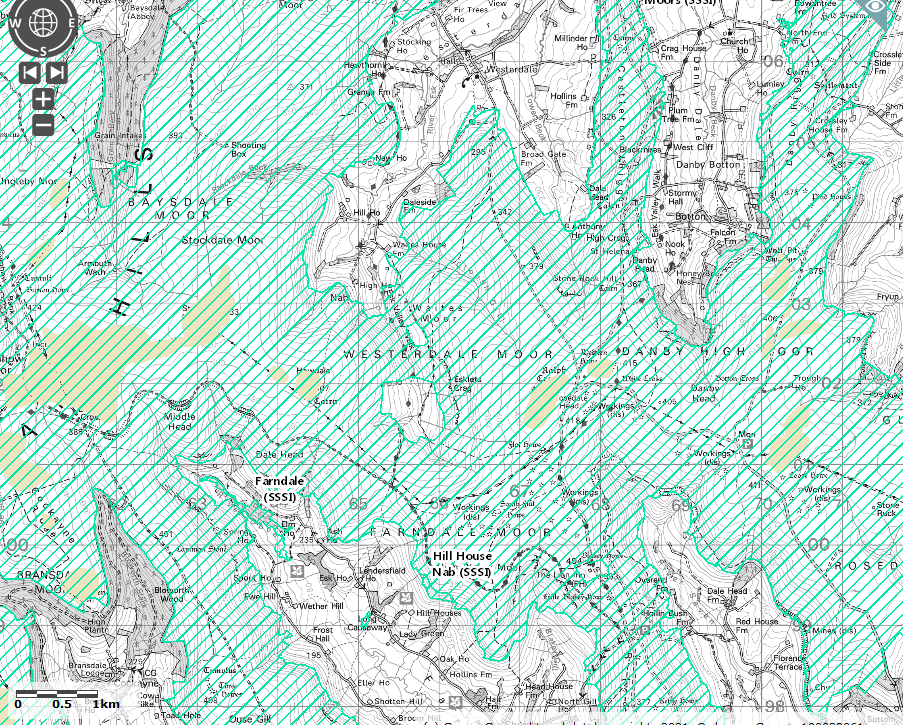
Heather burning on peat soils in the North York Moors will be little affected by this measure.
All SPAs and SACs are SSSIs too, but not all SSSIs are SACs or SPAs. Do the ecosystem services of peatland out of SACs and SPAs differ from those in them? And what about deep peat soils that are outside even SSSIs?
Since we have a map of blanket bog readily available let’s have a look around to see what the coverage of blanket bog (deep peat) outside SSSIs looks like.
Let’s first go to the Forest of Bowland area. If you drive, or walk, or cycle, along the road between Slaidburn and High Bentham, you have blanket bog, deep peat, on either side of the road for quite a stretch.

But is it SSSI and therefore caught by the DEFRA announcement? Let’s see by overlaying in green the SSSI, thus;
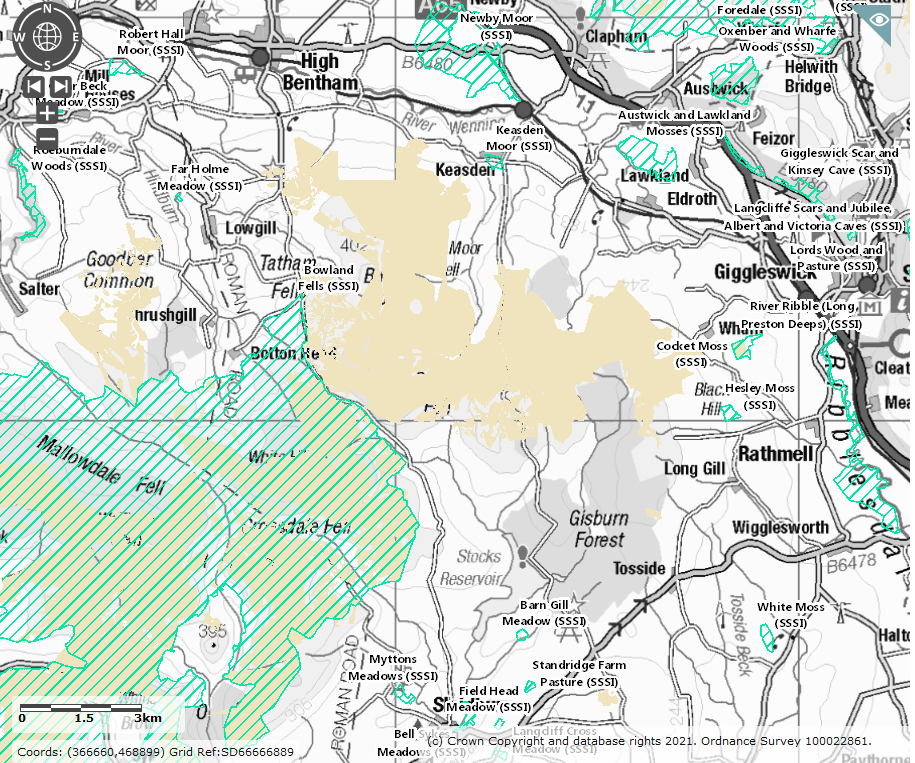
Ahh! Not so much! And that’s because SSSIs were not designed to cover all areas of nature cosnervation interest, they were meant to be representative examples, so they don’t give complete coverage or complete protection. The impact here is that massive areas of
deep peat, no doubt about it, deep peat, will still be burnable under these new measures aiming to save England’s rainforests.
That’s just one example, but there are plenty more, here’s another from the Yorkshire Dales where the blanket bog, deep peat, is that buff colour but the only bits that won’t be burnable are those also shaded in green hatching;
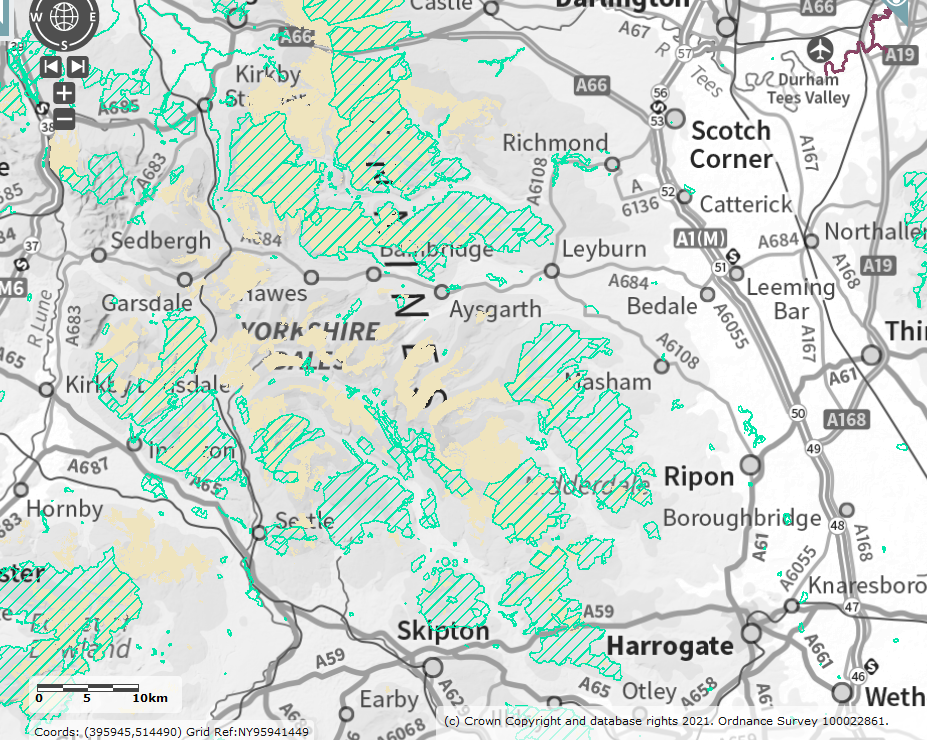
…there are plenty of gaps aren’t there?
We have to wonder how many licences Natural England, the friend of the grouse moor manager, will issue to allow them to get round these measures anyway.
And what is going to count as steep and/or rocky? We are talking about hills!
It is clear that the government’s announcement does not protect all peatlands, as we were promised, and because it doesn’t attempt to protect areas of significant peat but <40cm in depth, and it doesn’t even lead to the protection of deep peat outside SSSIs then it’s hardly the great environmental leap forward we weree promised and which we need to implement. But it is something, it’s a fairly big something, and it’s more of a something than we had last week.
3. Should we all be thanking George Eustice for being an environmentalist?
Given that we were all promised no burning on peatlands, this comes nowhere near that, we shouldn’t go overboard in heaping praise on DEFRA. And we were promised it for last year, and this is this year. Too little, too obviously caveated, and late. It’s all a bit shoddy. So, no, we shouldn’t be sending bouquets to DEFRA. This is a hard-won, medium-sized step forward. It took many people a lot of effort even to get this – that is the measure of the hopelessness of our Environment Department.
Many rules have exceptions – that’s not unusual. And it isn’t even bad, of itself. Let’s take the Birds Directive and Wildlife and Countryside Act – all birds are protected by law. But then there follow a whole lot of exceptions, most of them sensible exceptions provided that they are implemented sensibly (through licensing) and enforced (which they aren’t). In this case, the climate, the flood risk and the water quality won’t distinguish between burning across the top of a 50cm column of peat and a 20cm column of peat, nor between a 41cm peat column off an SSSI and one on an SSSI which is also an SPA and SAC. The exceptions are frankly ludicrous and it’s impossible to believe that they are anything other than the result of lobbying by a powerful but unimportant bunch of land-owning cronies of the party of government who really don’t give much of thought to environmental damage.
No, we should not thank George Eustice for this – he has failed yet again to deliver for the environment. In so doing he can hardly damage this government’s credibility because, apart almost solely for Zac Goldsmith (who has been made to look like a liar by this announcement which has not delivered what he promised), this government always caves in to vested interests rather than delivering the real interests of people and wildlife. You can kind of expect that from the Business Secretary, or the Chancellor (it almost goes with their job descriptions) but we have had a succession of Environment Secretaries who fail the environment while having the power to do good. We should hold Eustice to account for failing to do the good he could.
4. What do people say?;
Martin Harper, RSPB – click here. Sorry Martin, that is unutterably feeble. on Twitter Martin says his piece explains why loopholes ‘might undermine its [DEFRA’s] best intentions‘ which is crediting them with best intentions whereas the evidence suggests that there are bad intentions embedded in this policy.
Craig Bennett, Wildlife Trusts – quoted in the Guardian as saying ‘Why does the ban only apply to some of our designated peatlands? It should apply to them all. It will be extremely embarrassing if we are still burning any of our peatlands when the climate conference meets at the end of the year.‘ but the Wildlife Trusts website doesn’t mention the announcement.
Guy Shrubsole of Rewilding Britain says there are ‘some glaring loopholes that need closing‘ which is British understatement gone mad!
Amanda Anderson of the Moorland Association says her members welcome the announcement because they care so much about the climate and biodiversity – if you can really be bothered, click here.
Tom Orde-Powlett, vice chair of the Moorland Association was quoted in the Telegraph that the measures could threaten the viability of driven grouse shooting in England, which is a much more interesting quote than any of the others. I wonder whether he was grinning and had his fingers crossed behind his back when he said that.
Tony Juniper of Natural England says ‘This is a hugely welcome announcement which will see better protections for our globally important peatlands.‘.
5. What next?
We must wait for the much-delayed and still-delayed England Peat Strategy and it will be interesting to see what that actually says.
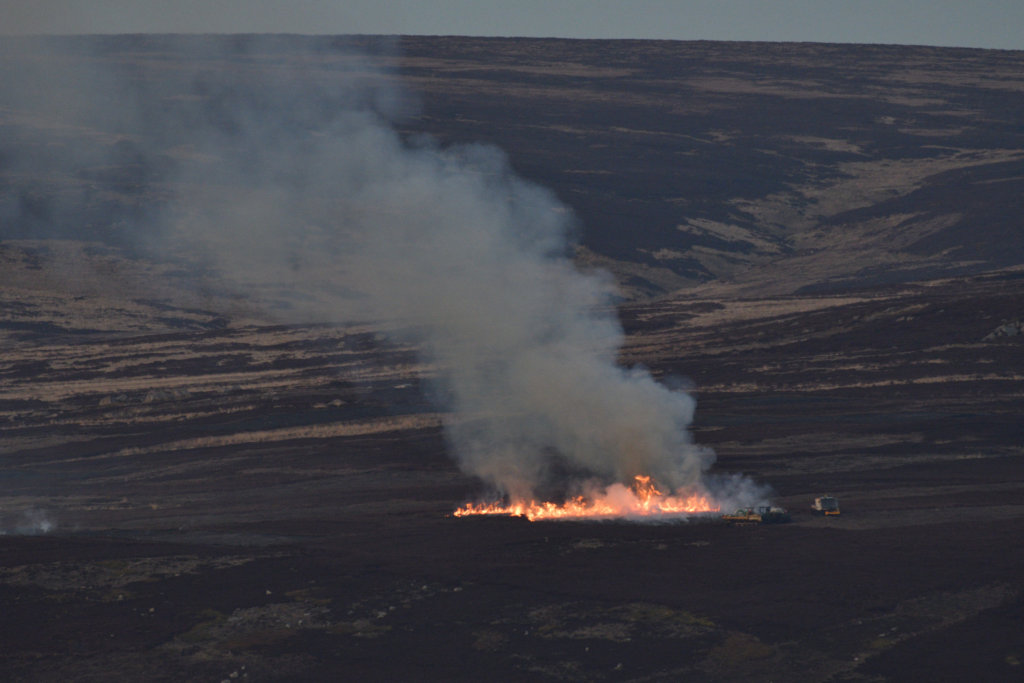
The good thing about heather burning is that a fire on the hill is pretty obvious, even at night, and the evidence is there afterwards too. If I lived in the English uplands I’d be learning to use the MAGIC map system to understand where the deep peat is in my area, and be going around taking photographs of the habitat even now for future reference. I’d be preparing to inform Natural England, the Environment Agency, DEFRA and maybe even the Police about non-compliant burning on deep peats (there will be some) and all but the Police in that list about burning on so-called shallow peat soils and off SSSIs. The public will have a big role in policing these coming regulations and also describing the scale of the continuing burning that DEFRA has allowed through its flawed system. This is still a burning issue.
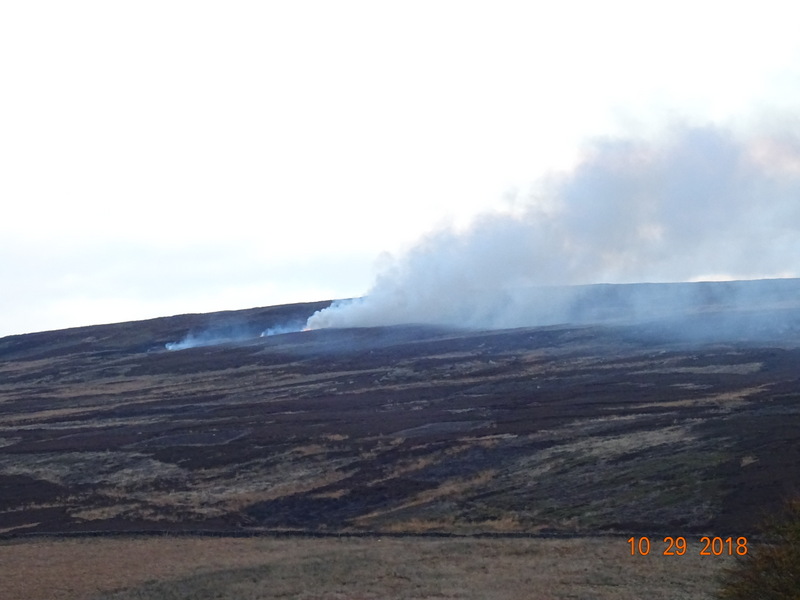
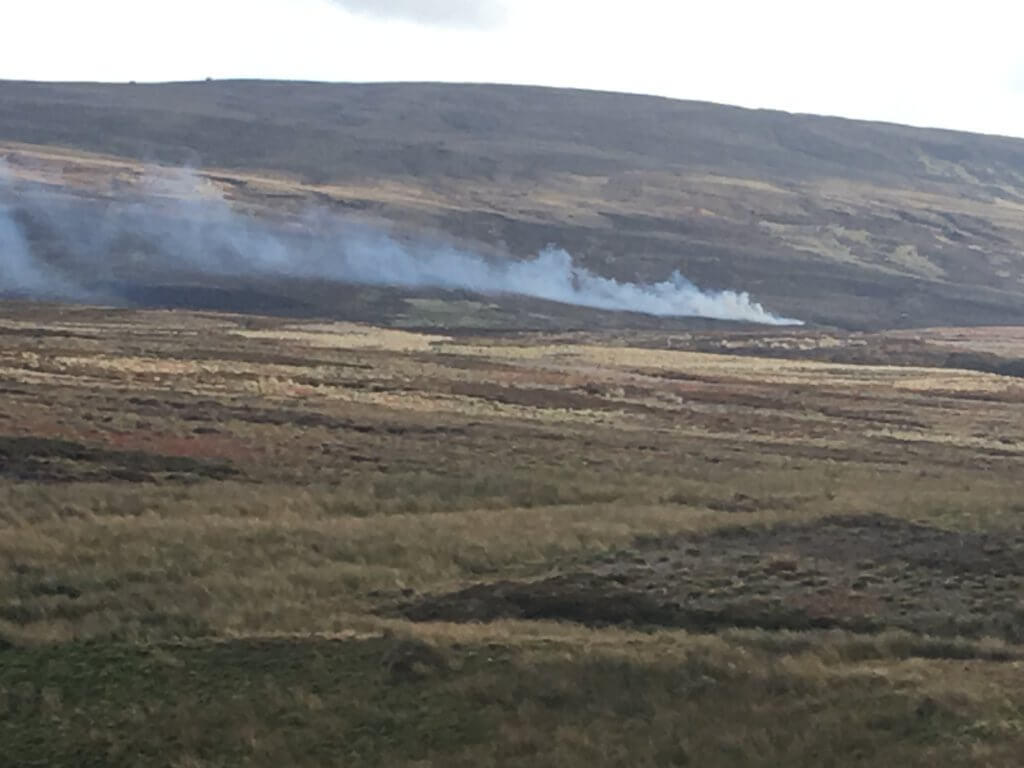
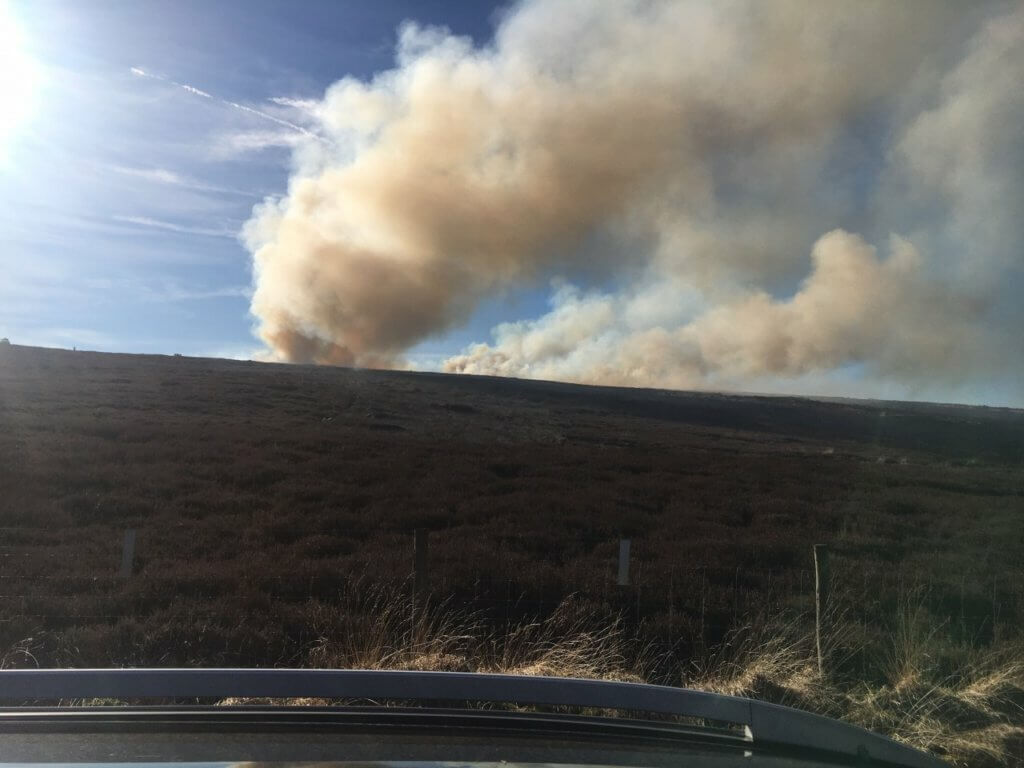
“The new regulations will prevent the burning of any specified vegetation on areas of deep peat (over 40cm depth) on a Site of Special Scientific Interest THAT IS ALSO a Special Area of Conservation or a Special Protection Area”
Another concern. SPAs and SACs are still valid designations post-Brexit but what is their longer term future? With a government full of people with a doctrinaire antipathy towards all regulations that ‘fetter business’ will future legislative developments result in these “gold plated” protections (to quote George Osborne) being done away with?
Jonathan – good point. Not immediately but … ?
Although the SPA/SAC designations are derived from the EU Habitats & Species directives, they are part of a broader umbrella, the Berne Convention with is not EU-dependent.
The followign is taken from wikipedia “SACs complement Special Protection Areas and together form a network of protected sites across the European Union called Natura 2000. This, in turn, is part of the Emerald network of Areas of Special Conservation Interest (ASCIs) under the Berne Convention. The Bern Convention on the Conservation of European Wildlife and Natural Habitats, also known as the Bern Convention (or Berne Convention), is a binding international legal instrument in the field of Nature Conservation, it covers the natural heritage in Europe, as well as in some African countries. The Convention was open for signature on 19 September 1979 and came into force on 1 June 1982. It is particularly concerned about protecting natural habitats and endangered species, including migratory species.”
Louise – true, but not usually very important. The Natura2000 designation is the premier league of protection. Of course the SPAs come from the Birds Directive and the Habs Directive (author, Stanley Johnson) came a long a bit later. the implications of th Birds Directive were mostly incorporated into UK legislation (pre-devolution) in the Wildlife and Countryside Act.
A problem with international conventions such as Berne, Bonn (migratory animals), Ramsar (wetlands), etc is that they generally do not have much in the way of teeth to prevent backsliding by signatories. The Habitats and Birds Directives differ in that there are real sanctions that can be applied when EU member states don’t comply. Hopefully, as a signatory to Berne in its own right, the UK will continue to uphold its undertakings but I for one cannot help feeling nervous when I see the attitude of many Tory MPs and ministers towards environmental protections (i.e. they are a ‘good thing’ up to the point at which they interfere with the ability of businesses to operate as they see fit).
Mark, you sum it up beautifully. It’s a half measure designed to support the DGS friends/donators of the tories and pacify the environmentalists. Of course this won’t pacify us and we’ll continue to campaign in order to secure proper measures.
Thanks for your blog and efforts.
Well said Mark a very good in depth analysis. The trouble is when one starts to make many exceptions to a blanket burning ban (which of course should have been applied) on the burning of our moorlands, someone or some organisation needs to monitor the regulations and these exceptions to ensure they are being adhered to.properly. This should be a significant piece of work if done properly. . I doubt whether this rotten Government will even come close to producing sufficient funds to undertake this necessary monitoring.
No, I think we view this Defra statement with great disappointment as we frequently view many Defra statements from this Government. This to my mind all “stinks” as it is clearly designed to allow those that like to kill our wildlife for fun to carry on burning much as they have always been doing. The shooters must be “rubbing their hands” with pleasure when they read this statement and muttering under their breaths that apart from well known deep peat spots on moorlands, these regulations are going to be pretty well totally unenforceable. As you say Mark yet again and again Eustice has been useless and failed our environment. but no doubt he is very popular in Tory shooting circles.
As for Mr. Juniper his statement is just ridiculous which no sensible person should believe for a moment. I am surprised he has turned out to be just the obedient propaganda “ poodle” of Eustice.
Mark, thank you for your very clear analysis, as usual. I agree with the more pessimistic comments here – a glass half empty rather than half full. I think and , based on last night’s program, David Attenborough also will think that the Govt could have done so much more.
I will be very interested in hearing Zac Goldsmith’s take on the obvious loopholes embedded in this announcement as it clearly does not go as far as he previously intimated. Unlike Tony Juniper I don’t thing Zac has, as yet, gone over to the dark side..
On a more positive note it was interesting to see from your maps that key grouse shooting areas in upper Swaledale, Wensleydale and in particular Nidderdale do appear to be covered by the proposed legislation. Monitoring the outcome in these areas could become a new pastime. I would be interested to hear Paul’s view on this particular area.
Dallowgill have in the past cut, admittedly to supply heather for a regeneration project on a neighbour but it could become more widespread although much of their moors are shallow peat. Swinton, Blubberhouses and I think Fountains Earth have all burnt since the voluntary moratorium. It will be very interesting to see what happens on YW land and on Bolton Abbey who are normally compliant with rules. I think we will need measuring poles, to check the peat depth in every burn ( ten for an average may be) I’m sure the pressure will remain on them from Moorland Monitors etc.
“view this Defra statement with great disappointment as we frequently view many Defra statements from this Government”
It’s nearly as disappointing as when Hilarity Benn – among others – kicked the European Soils Directive into the long grass. It might have done something about destruction of peatlands. If I remember correctly Mr Bean was not from this Government
I think you give DEFRA too much credit in saying this announcement is good news. Looking at your analysis makes me think it is more of a cynical ploy to see how little protection can be offerred so that their grouse killing friends(and donors) can cary on regardless. It is good that there is at least now something in writing which can be critiqued, over which DEFRA can have it’s feet held to the fire as it were.
As it stands though these proposals are a paper tiger that will blow away in the wind on first contact with a grouse moor
Gerald – I think DEFRA are well known for feeling that I am too kind to them in my views. It’s a fault perhaps.
We need to get adept at measuring peat depth then. This as Mark explains hardly protects all peat soils even if it is in the designated areas only those deemed deep enough to form blanket bog, bit arbitrary and of course there are quite large areas of land used for DGS that are on thinner peat soils, which may be even more prone to drying out and oxidation. It’s all a bit flim flam by pretending a great change when it is good but nowhere near as good as it should have been. I used to this T O_P was one of the better moorland owners now he seems just as bad as all the rest and they are of course are totally bloody awful.
40cm will be lower than the kneecap on most adults. Most of the peat over Kinder, Bleaklow and the north-east moors (leading out to Sheffield) of the Peak District is over a metre. Stand in the bottom of a grough and a lot of the time you don’t see the horizon. Which means it is over 2m in lots of places.
I’ve personally measured the depth of peat at a location near Horton-in-Ribblesdale (Black Dub Moss) as being in excess of 1.1m That’s how far I sunk into emulsified peat (a bit above waist, and my feet didn’t touch solid bottom). Like the Peak, a lot of the high ground of the Dales is covered with a lot of peat.
A lot of the Warcop ranges and higher Northern Pennines are over a metre in depth. Again, standing in groughs gives an indication of the overall depth of peat.
There is a lot of deep peat along the Pennines.
tuwit – we know, it’s mapped too, like the blog says. Thanks.
Your excellent analysis highlights that this is yet another typical government strategy designed to quieten opposition while proceeding with business as usual. Similar to recent announcements about the badger cull which gave rise to totally misleading headlines from the BBC.
The recent case of forestry ploughing on deep peat in Cumbria would suggest that knowledge of where the deep peat is is either incomplete or not available where it is needed – whilst it was wrong there was no suggestion that the Cumbria case had gone ahead in the full knowledge it was on deep peat.
What splendid hypocrisie to reach for a Brexiteer to reach for a European designation to sneakily limit the extent of his action – surely the true blue, British SSSI must rule ? But then patriotism is, of course, the last refuge of a scoundrel.
I think it would be very helpful if an SPA owner decided to challenge this in the court. NE would then have to justify the unjustifiable……again.
GWCTs stamen on this is interesting, entirely predicable but shows what we are up against https://www.gwct.org.uk/blogs/news/2021/january/our-statement-on-the-banning-of-all-managed-winter-
Shows quite clearly the intention of the DGS cabal to continue this bad practice where ever they can. that is why the DEFRA policy has all those loopholes!
This is clearly a complex and very technical, and important, subject which your article does nothing to elucidate. May I suggest that somewhat with as deep and broad knowledge of the subject as yourself rewrites the articl in clear English, explaining everything clearly, leaving out the “ranting” bits.
David – you’re free to suggest tht of course.